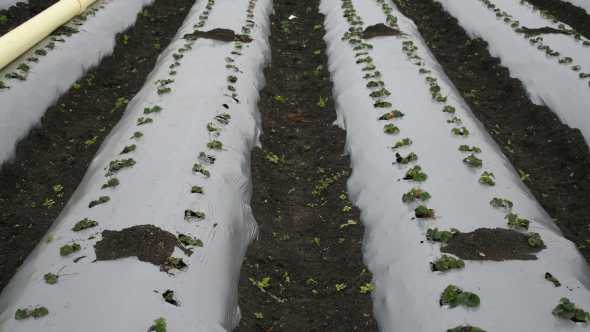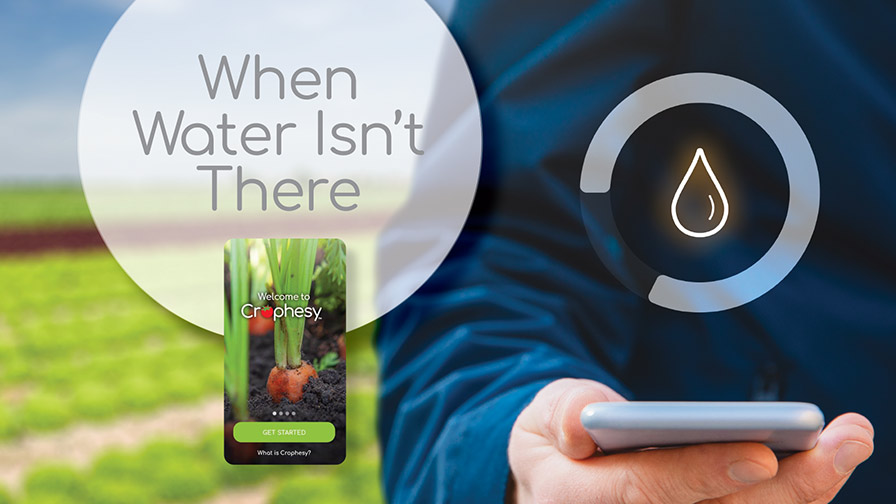Moving Beyond Methyl Bromide With Biofungicides

These strawberries were planted in November and are shown here in mid-December. The bed on the right had Actinovate applied to the transplants at planting followed by another application a few weeks later. The bed on the left did not have this treatment – the difference in plant size was statistically significant. Photo courtesy of Mark Bolda
Editor’s note: University of California Farm Advisor Mark Bolda will present much more information on this topic at the Biocontrols USA 2016 Conference & Expo, March 3-4 in Monterey, CA. Register for the conference, along with an optional or workshop at BiocontrolsConference.com.
There’s nothing currently available to growers that provides the same all-around preplant fumigation results methyl bromide did, and perhaps there never will be. But that doesn’t mean there aren’t effective programs you can implement in your crops, and biofungicides are an interesting new tool in that mix, says Mark Bolda, Farm Advisor in Strawberries and Caneberries with University of California Cooperative Extension.
“Biological fungicides have been part of the picture for some time, but not that many have been tested in university trials. And certainly not in strawberries,” he says. “As we transition from methyl bromide, we cannot be leaving any stone unturned. We have to look at everything.”
PrePlant Fumigation Programs
The loss of methyl bromide left growers looking for alternatives to battle tough soil diseases like Verticillium, Macrophomina, and Fusarium. But Bolda says those diseases aren’t really the target of his research with biofungicdes. His goal in trialing the technology is not to completely eliminate soil pathogens, but to keep them in check enough to help the plants perform better.
 “I’m working on plant performance. I am not necessarily focused on these materials as being toxic to fungi — but they do seem to be enhancing plant performance to some extent.”
“I’m working on plant performance. I am not necessarily focused on these materials as being toxic to fungi — but they do seem to be enhancing plant performance to some extent.”
At this point, research has been combining alternative chemical fumigants with other materials, including biofungicides. In the 2013 production season, Bolda tested 14 different biofungicide materials in a series of strawberry trials. He saw clear plant response with a few of the products, including Bacillus amyloliquefaciens (Double Nickle, Certis), Trichoderma virens (SoilGard, Certis), Bacillus subtilis (Serenade, Bayer), and Streptomyces lydicus (Actinovate, Monsanto).
He followed that up in 2014 by testing this smaller list of products in soil that had been treated with anaerobic soil disinfestation, which is flooding with the addition of a carbon source. In 2015, Bolda narrowed testing down to one product which had shown the best results in his ’14 trials, an application of Streptomyces lydicus (Actinovate), following an application of a chemical fumigant called allyl isothiocyanate (Dominus, Isagro USA).
“We saw good results. It did help us close the gap between what we would achieve with Dominus alone and what we normally see with methyl bromide,” Bolda says.
Improve Plant Performance
As an illustration, he says to look at the crop yield you would have expected using methyl bromide.
“With something like Dominus in trials, I was looking at an 80% yield in comparison to what we may have gotten using methyl bromide. As a grower I’m looking to do whatever I can do to close that 20% gap in plant performance — better fertility practices, or managing the plant a little bit better at planting. I can also use some of these biological fungicides which may give me between a 5% and 10% boost in yield. That’s what I’m looking for,” he says.
What growers need to start doing, Bolda says, is ask, “How do I close the gap between what I used to get with methyl bromide and where I am now?”
“If you use these things to try and prevent fungal infection of the plant, that’s not the way I would be thinking. I think that’s a mistake. If you have a material you can put on the plant and continue to put through the drip tape once a month, and it’s going to give you a 5% or 10% gain in plant performance, that’s good.”
The cost for real gains is a reasonable investment, Bolda says.
“Adding some of these biofungicides is not that expensive. In our trial, an application is about $20 an acre. You do that once or twice a month. With something like strawberries which is a very high-value crop per acre, it’s really affordable and if it gets you that 5% or 10% increase in yield, the gain is significant.”
Bolda’s work with strawberries is continuing. He also has a trial in blackberries this year and expects to see similar results. The key, Bolda emphasizes, is that growers not expect too much. There’s simply not a single solution to replacing what methyl bromide did. But that may not be a bad thing.
“When you use these fumigation alternatives, you’re leave behind a different soil ecology than you did fumigating with methyl bromide. Biological fungicides are, by and large, fungi and/or bacteria. I’m using living organisms. It may perform better in a soil that’s been treated with an alternative than it would in a soil that’s been treated with methyl bromide,” Bolda says. “Biofungicides are additive in a strong program of plant culture.”










